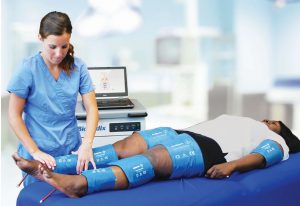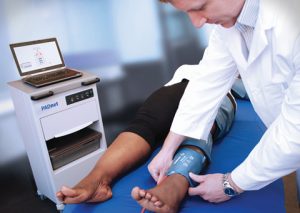Advanced Podiatry Specialists Specialists offers non-invasive vascular testing for peripherial arterial disease (PAD) & chronic venous insuffiency (CVI)
We are pleased to offer the newest and greatest technology with the PADNet 2.0 from Biomedix for testing for these diseases by checking for: pulse volume recording right measurements…

- Pulse Volume Recording (PVR) measurements
- Segmental blood pressures used to calculate:
- Ankle-Brachial Index (ABI)
- Toe-Brachial Index (TBI)
- Segmental-Brachial Index (SBI)
- Venous Refill Measurements
- Venous Outflow Measurements

- Do you suffer from tired legs?
- Muscle pain/cramping with activity?
- Leg numbness or weakness?
- Coldness in your lower legs, feet, or toes?
- Shinny skin to your lower extremities?
- Change in color in your lower legs, feet, or toes?
- Hair loss or slower hair growth in your lower extremities?
- Thickened, fungal toenails with slow growth?
Even if you don’t have symptoms of peripheral artery disease, you may need to be screened if you are:
- Over age 70
- Over age 50 and have a history of diabetes or smoking
- Under age 50, but have diabetes and other peripheral artery disease risk factors, such as obesity or high blood pressure
Peripheral artery disease is often caused by atherosclerosis.
- In atherosclerosis, fatty deposits (plaques) build up in your artery walls and reduce blood flow.
- Although the heart is usually the focus of discussion of atherosclerosis, this disease can and usually does affect arteries throughout your body. When it occurs in the arteries supplying blood to your limbs, it causes peripheral artery disease.
- Less commonly, the cause of peripheral artery disease may be blood vessel inflammation, injury to your limbs, unusual anatomy of your ligaments or muscles, or radiation exposure.
Risk Factors
Factors that increase your risk of developing peripheral artery disease include:
- Smoking
- Diabetes
- Obesity (a body mass index over 30)
- High blood pressure
- High cholesterol
- Increasing age, especially after reaching 50 years of age
- A family history of peripheral artery disease, heart disease or stroke
- High levels of homocysteine, a protein component that helps build and maintain tissue
*People who smoke or have diabetes have the greatest risk of developing peripheral artery disease due to reduced blood flow.
Complications
If your peripheral artery disease is caused by a buildup of plaques in your blood vessels (atherosclerosis), you’re also at risk of developing:
- Critical limb ischemia. This condition begins as open sores that don’t heal, an injury, or an infection of your feet or legs. Critical limb ischemia occurs when such injuries or infections progress and can cause tissue death (gangrene), sometimes requiring amputation of the affected limb.
- Stroke and heart attack. The atherosclerosis that causes the signs and symptoms of peripheral artery disease isn’t limited to your legs. Fat deposits also build up in arteries supplying your heart and brain